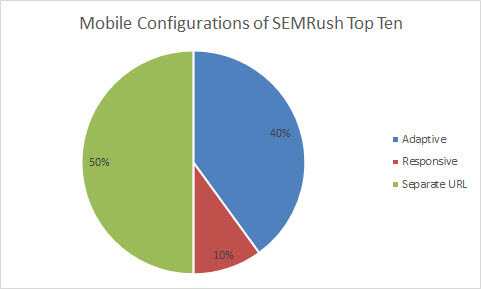Proof that no ranking boost for responsive sites exists in 2017
There are many good reasons to recommend responsive design to a client or to your company, but achieving better search results isn't among them, argues columnist Bryson Meunier.
 Let’s put the mobile configuration debate to bed.
Let’s put the mobile configuration debate to bed.
For those of you who haven’t been following closely, the industry discussion about mobile design options involves whether it’s better to use responsive web design, adaptive design or separate URLs to achieve better search rankings.
Because responsive web design is Google’s stated preference, many SEOs assume that it is always the best choice for SEO. I have on many occasions questioned this assumption, but, for many, the question remains.
Google has said that there is no special ranking boost for responsive sites, but explains that responsive is their preference because it’s easier for everyone. Do we believe them? Let’s test the hypothesis that there is no special ranking boost for responsive sites.
If there were a special ranking boost, I propose that we would see the following:
- When we look at the websites that get the most organic traffic from Google search, the majority of them will be responsive.
- A majority of websites are responsive in 2017, so the percentage of sites with a lot of Google search traffic that are responsive will likely be higher than the percentage of sites overall.
- The websites that get the most traffic from search will have a higher percentage of responsive sites, as opposed to separate URLs or adaptive sites.
In order to test this, I looked at the top 100 sites — the sites with the most organic mobile search traffic from Google — according to SEMRush.
After subtracting porn sites, I had a list of 94 sites. I crawled these sites using Screaming Frog, with the user agent set to Googlebot smartphone, to see which of them redirected to separate URLs, and the rest I manually visited to see if they were adaptive or responsive.
And the hypothesis failed. The three points above did not hold true. If there is a ranking boost for responsive sites that Google hasn’t told us about, the data from the top sites suggests that it’s so small that it doesn’t override other signals.
When it comes to the top 100 websites with the most traffic, responsive is the most common mobile configuration strategy at 54 percent:
This is followed by adaptive sites at 28 percent and separate URLs at 17 percent. None of the top 94 sites were mobile-unfriendly — all used one of these three options.
This satisfies the first point, but, by itself, it doesn’t prove a responsive ranking boost.
To do that, the percentage of top sites — as measured by overall organic traffic — would have to have a higher percentage of responsive sites than all sites. We know, based upon a study by Appticles published in Smashing Magazine, that the percentage of all sites that are responsive comes in at 52.11 percent. So, the percentage of responsive sites in the SEMRush 100 is higher, but only by 2.06 percent.
The story is the same for separate URLs, with 1 percent more sites with separate URLs appearing in the SEMRush 100 sample than in the sample of all sites. Neither one of these differences is statistically significant.
When we look at the major differences in the chart, we have to also look at adaptive sites and sites with no mobile configuration. If anything, this chart suggests that:
- mobile configuration makes a difference in ranking, as there’s a much lower percentage of non-mobile friendly sites in the SEMRush sample (zero) than in the overall sample, and
- adaptive sites could have a ranking boost, as there are many more of them in the top sites sample than in the sample of sites overall.
It’s more likely, however, that there are more adaptive sites in the sample of top-100 sites because adaptive design can only be achieved with significant resources — and the top sites in the world are likely to have access to greater resources than the average blog or local business site.
The bottom line is, there’s nothing here to suggest that responsive sites are somehow more successful at SEO than sites that use Google’s other two supported mobile configurations.
When we look at the last criterion on my list, we don’t see a responsive ranking boost either. The top site in the list, Wikipedia, uses separate URLs.
As does Facebook, the number 2 site, YouTube, the number 3 site, and imdb.com, the number 4 site. The next two sites on the list, Amazon and Google, are both adaptive. There was only one site in the top 10 that is responsive, and that is fb.com, a domain of Facebook’s.
Because the largest sites in the list are not responsive, we see that separate URLs, and not responsive sites, get the most search traffic (according to SEMRush’s estimates). There are fewer sites on the list employing the separate URL strategy, as compared to responsive, but these sites have more than 2x the organic search traffic than responsive sites in the list:
So, let’s stop kidding ourselves. If you’re an SEO and you recommend responsive web design to your clients or your company, that’s great. There are many good reasons to recommend it, but one of those reasons is not that it will help you in organic search results (beyond the mobile-friendly ranking boost that all mobile sites receive).
If you have good reasons to make your site adaptive or on a separate URL, follow Google’s guidelines and you can do just as well in search — something Wikipedia, Facebook, Google, Amazon and IMDB already know.
Google may say their preference is responsive, but the data shows adaptive sites and separate URLs often do better than responsive sites in search.
Contributing authors are invited to create content for Search Engine Land and are chosen for their expertise and contribution to the search community. Our contributors work under the oversight of the editorial staff and contributions are checked for quality and relevance to our readers. The opinions they express are their own.
Related stories
New on Search Engine Land



